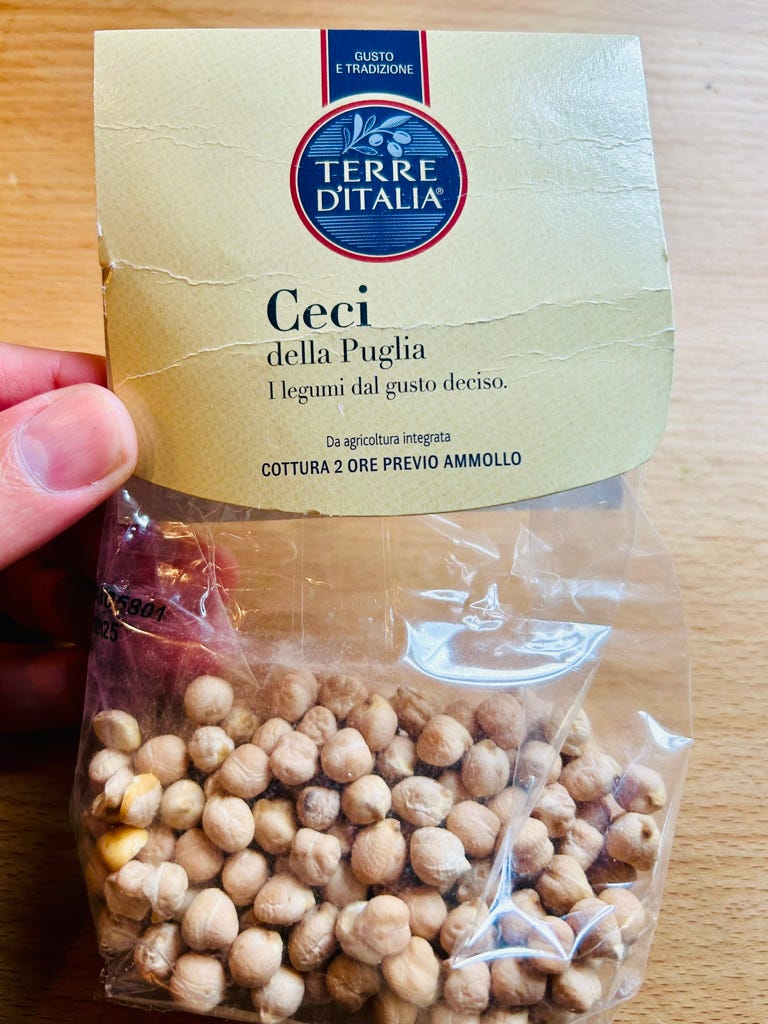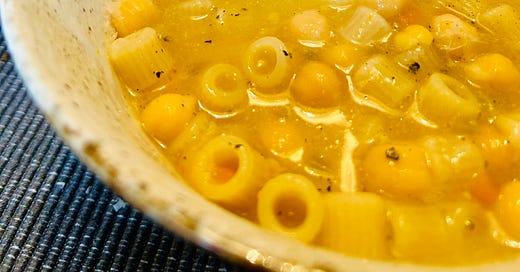I hope you enjoyed my reflections on Italian vegetarian food and the mangiare di magro concept so dear to Italian culture. If not check it out here.
In the article I mention how legumes have been a staple of everyday southern Italian cuisine for centuries, because of their availability, nutrient qualities and accessibility when it comes to price.
One of the legumes dishes that I love and that I have learned from my mother is this very simple pasta with chickpeas. This type of dish and cooking technique can be applied to pretty much any legume that is common in Italy (beans, chickpeas, lentils, fava beans etc…).
The chickpeas need to be soaked, usually the previous night, or early in the morning if you are planning to cook it for dinner, but read the instruction package as soaking time can vary greatly. After they are soaked they will double in size, and you can rinse them and cook them with a mixture of onion, celery and carrot directly in the water. Some people prefer to do a classic soffritto with these aromatics and then add the water to cook the chickpeas. Both are possible but this is the way my mother makes it.
It’s halfway between a minestra and a pastasciutta so you can cook the pasta directly in the soup (like in the recipe) or separately and add it at the end.
The easiest way is to cook the pasta separately, so that you can keep reducing the liquids in the chickpea broth if too runny, or add more liquid if too dry, without affecting the doneness of the pasta. Don’t forget to add some cooking pasta water when you mix it in the end. You can use this technique also if you want to save some of the chickpeas for later usage.
If you cook the pasta directly in the soup the result will be more creamy because of all the starch released by the pasta. The tricky part of cooking pasta directly in the soup is that you have to end up with the right amount of liquid when the pasta is cooked al dente, which can be difficult to guesstimate when you do it for the first few times.
There is in fact a lot of variation possible with the consistency of this dish and it’s up to you to experiment a bit to end up with your favourite style. It’s almost impossible to give perfect ratios as the amount of liquid left in the end depends greatly on many factors such as the quality of the chickpeas, the size of the pot, the intensity of the boiling etc…
My mother uses the following technique and it gives you a fair amount of leeway when you want to adjust the consistency at the end of the process:
At step 6 you set aside roughly three ladlefuls of cooking liquid. This needs to be liquid only, no chickpeas! This liquid will help to hydrate your pasta at the end if it’s is too dry.
At step 7 you set aside and blend one ladleful of chickpeas. This can be mostly chickpeas but there should be some liquid too or else it will be very difficult to blend. The puree will help when the dish is too liquid and it’s always good to add to obtain a creamy and smooth consistency.
My ladles are roughly 125ml (1/2 cup)

I’m always amazed of how much flavour there is in this dish with simple and very basic cheap ingredients. It doesn’t look spectacular but it’s delicious and healthy and an amazing winter night comfort bowl.
As always hit me with some questions if some passages are not clear. I will work on making a video soon.
I normally have recipes behind a paywall but I made this post available to all subscribers as I had promised the recipe to my social media followers.
Pasta e ceci
Serves 4-5
Ingredients
200gr/7oz dried chickpeas
1.5 litres / 1.6 quart of cold water
2 dried bay leaves
1 small onion (about 100gr/3.5oz)
1 celery stick (about 50gr/1.7oz)
1 carrot (about 100 gr/3.5oz)
1 tsp wild fennel seeds
250gr/9oz Pasta (ditalini or other very small pasta format)
Salt to taste
Extra virgin olive oil for finishing (Chilli olive oil is also great on this)
Grated parmigiano for finishing (optional)
Instructions
Soak the chickpeas overnight according to package instructions. Rinse the chickpeas and discard the water.
Add 1.5 l of water to a large pot.
Finely chop the onion, carrot and celery and add them to the water.
Add fennel seeds, bay leaves and dried chickpeas to the water.
Cook covered on medium/low until chickpeas are cooked but still have some “bite”. (Package should have instructions on cooking time, it should be at least 1 hour). The water should bubble gently and I usually leave the lid slightly “ajar” in order for a little bit of steam to escape.
Adjust salt to taste and set aside 3 ladlefuls (about 375ml/ 1.5 cups) of the liquid in which the chickpeas have been cooking (liquid only).
Separately from that set aside 1 ladleful (about 125ml/ 1/2 cup) of chickpeas and liquid and blend them with an immersion blender or a regular blender to a puree.
Bring the pot with the chickpeas to a boil and add the pasta.
When the pasta is al dente remove from heat. If it’s too dense use some of the cooking liquid set aside (at 6) to dilute until desired consistency.
Discard bay leaves and add the reserved chickpea puree. This will make the pasta more creamy in consistency.
Check seasoning and serve hot with a drizzle of olive oil and some grated parmigiano to taste.






Looks fabulous - plus, that focaccia in the background and a glass of red...it is impossible to go wrong with that combination!
Looks delish I will try tonight!!!